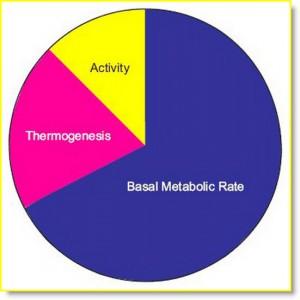 Everyone is aware of the fact that calorie intake is a key component in the weight loss war, but how do you pinpoint how many calories you should eat daily?
Everyone is aware of the fact that calorie intake is a key component in the weight loss war, but how do you pinpoint how many calories you should eat daily?
There are 3 different components that need to be examined:
Your BMR, Basil Metabolic Rate
Your TEF, Thermic Metabolic Rate
Your Activity Level
Let’s begin with your BMR. Your basal metabolic rate refers to how many calories your body needs to consume each and every day just to stay alive; to keep your brain functioning, your heart beating and your lungs taking in oxygen in order to keep you alive.
For the most part, your BMR is determined by your body weight and lean muscle mass, however there are other factors that come into play such as your overall activity levels, climate, stress levels and overall health etc.
To approximate your BMR, multiply your body weight by 10.
Next we’ll look at the TEF…the thermic effect of food. This refers to how many calories your body is going to burn simply breaking down the food you eat. Each time you eat a meal your body is going to burn calories digesting it so this gets added to your daily calorie burn.
Different foods will require differing amounts of energy to break down and digest (protein has the highest thermic effect of all food) but on average assuming you are eating a mixed diet, you’ll be looking at about 15% being attributed to this thermic effect of food factor…the TEF.
The last component to assessing calorie intake is your daily activity burn. Essentially this tells you how many calories you burn off on a day to day basis when performing your normal lifestyle activities.
Think about your daily activities, not including your workout sessions and place yourself in one of these categories:
- Sedentary: 1.1 (office job)
- Lightly Active: 1.2 (office job but you’re on your feet often throughout the day)
- Moderately Active: 1.3 (on your feet all day-hair dresser, teacher, store salesman)
- Very Active: 1.4 (constant movement-manual labor, construction worker, etc.)
Take the number you arrive at above and multiply this by the factor for your activity level.
This tells you your maintenance calorie intake.
Since your goal is to lose weight, you’ll need to subtract calories from this so that your body is turning to body fat as a fuel source.
It takes 3500 calories to burn off one pound of body fat, so you’ll want to use a deficit of around 250 (1/2 pound per week) to 1000 (2 pounds per week).
For the most part, I recommend that people use a deficit of 500 calories per day as this tends to be the sweet spot for most people.
When you first begin this process, you’ll need to count calories but as time progresses you will be able to get a feel for how much you’re eating and hit your targets naturally.
Planning your meals a day in advance will help you avoid any confusion as to what you should be eating every day.
Live by the 80/20 rule. Make good choices at least 80% of the time and the rest of the time you can indulge slightly. If you find you really need it, allow yourself one cheat day per week.
It’s important to maintain a healthy mindset, the idea is to find a balance. Don’t go overboard but don’t be too restrictive either.
If you are tired of the “yo-yo” diet syndrome and all you need is a little help to get you going in the right direction, check out my newest product “Rebound Free Weight Loss”.
Speak Your Mind